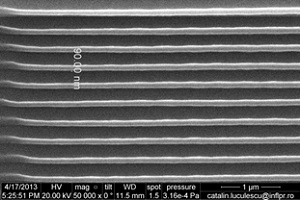3D Laser Lithography
Contact Person: Bogdan C?LIN
E-mail: bogdan.calin@inflpr.ro
Phone: 2423
E-mail: bogdan.calin@inflpr.ro
Phone: 2423
|
System Components
|
Performances
|
Features
|
 |
Technology
3D Laser Lithography is a Laser Direct-Writing (LDW) technique based on Two-Photon Polymerization (TPP) effect in photoresists.
Starting from a 3D CAD file (STL), by rapid prototyping algorithms fully three dimensional structures can be fabricated with submicrometer resolution.
A General Writing Language (GWL) script allows complex 3D designs and full control over the scanning path, laser exposure, automatic positioning and corrections.
Applications:
- Micro-optics
- Photonic crystals and metamaterials
- Scaffolds for tissue engineering
- Micro-fluidics
- 2D masks
References:
[1] Florin Jipa, Marian Zamfirescu, Alin Velea, Mihai Popescu and Razvan Dabu (2013). "Femtosecond Laser Lithography in Organic and Non-Organic Materials", Chapter in:"Updates in Advanced Lithography", Prof. Sumio Hosaka (Ed.), ISBN: 978-953-51-1175-7, InTech, DOI: 10.5772/56579. Available online at Intech.
[1] Florin Jipa, Marian Zamfirescu, Alin Velea, Mihai Popescu and Razvan Dabu (2013). "Femtosecond Laser Lithography in Organic and Non-Organic Materials", Chapter in:"Updates in Advanced Lithography", Prof. Sumio Hosaka (Ed.), ISBN: 978-953-51-1175-7, InTech, DOI: 10.5772/56579. Available online at Intech.